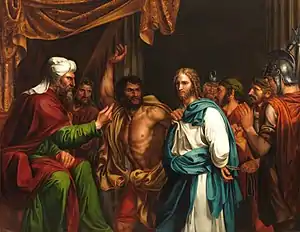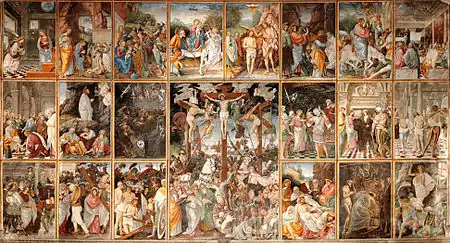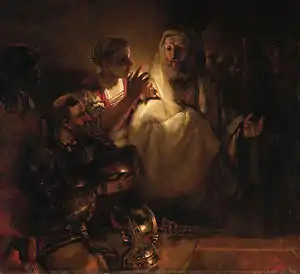Sanhedrin trial of Jesus
In the New Testament, the Sanhedrin trial of Jesus refers to the trial of Jesus before the Sanhedrin (a Jewish judicial body) following his arrest in Jerusalem and prior to his dispensation by Pontius Pilate. It is an event reported by all four canonical gospels of the New Testament, although John's Gospel does not explicitly mention a Sanhedrin trial in this context.[1]

| Part of a series on |
| Death and Resurrection of Jesus |
|---|
 |
|
Portals: |
| Events in the |
| Life of Jesus according to the canonical gospels |
|---|
 |
|
Portals: |
Jesus is generally quiet, does not mount a defense, and rarely responds to the accusations, but is condemned by the Jewish authorities for various accusations: violating the Sabbath law (by healing on the Sabbath), threatening to destroy the Jewish Temple, sorcery, exorcising people by the power of demons, and claiming to be the Messiah.[2] The Jewish leaders then take Jesus to Pontius Pilate, the governor of Roman Judaea, and ask that he be tried for claiming to be the King of the Jews.
The trial as depicted in the Synoptic Gospels is temporally placed informally on Thursday night and then again formally on Friday morning. However, since the Jewish preparation day begins on Thursday at sunset, according to the Gospel of John this informally happened on Wednesday night and then again formally on Thursday morning, with him eventually being taken off the cross on Thursday night, being the beginning of the Jews' 'day of preparation', as it is written at John 19:42.
The idea that the 'day of preparation' begins on Thursday night is thought by some to be an error due to the bias of later 'Christian' thought. This trial takes place in the night portion of the 14th day of the 1st month, i.e. Passover, making the 'day of preparation' a reference to the preparation of the Passover meal and the cleansing of the home of all leaven. If this is true, the 'Sabbath' the next day is not a reference to the weekly Sabbath, but the High Sabbath of the first day of the Feast of Unleavened Bread. Interestingly, John calls this Sabbath a "high one" in John 19:31 (KJV, but called a 'special Sabbath' in the NIV). The High (special) Sabbaths that are associated to the Biblical feast days (Leviticus 23) can fall on any day of the week, not just Saturday. It is the belief of most Hebraic believers that the Messiah was crucified on the afternoon of a Wednesday and rose again on the evening of the weekly Sabbath, just before the first day of the week, which began at sunset according to the Scriptural meaning of a day (Genesis 1, i.e. evening and morning). When the women went to the grave in the morning, his tomb was already empty, he was already gone. A Wednesday to Saturday time frame fulfills the only sign given that he was the Messiah, i.e. the sign of Jonah, three days and three nights in the grave (Matthew 12:40) and his claim that he would rise again on the third day (Matthew 20:19, Mark 12:34, Luke 24:46).
Trial
In the narrative of all the canonical gospels, after the arrest of Jesus he is taken to the Sanhedrin. From a historical perspective, in the era in which the narrative is set, the Sanhedrin body was an ad hoc gathering, rather than a fixed court.[3] The portrayal of the Sanhedrin contradicts that of Jewish tradition and texts, which portray the Sanhedrin to be an established court based in Jerusalem with strict guidelines on how to function.[4] This is often considered by Christian sources to have been a deliberate contradiction by the Gospel authors, accusing the Sanhedrin of illegally violating the Torah during the trial.[5][6][7]
In the four canonical gospels, Jesus is tried and condemned by the Sanhedrin. According to Luke, Joseph of Arimathea and Nicodemus dissent from this decision.[8] Jesus is mocked and beaten and condemned for various accusations, violating the Sabbath law (by healing on the Sabbath), threatening to destroy the Jewish Temple, sorcery, exorcising people by the power of demons, and claiming to be both the Messiah and the Son of God.[2][9][10] Although the Gospel accounts vary with respect to some of the details, they agree on the general character and overall structure of the trials of Jesus.[11]
Matthew 26:57 states that Jesus was taken to the house of Caiaphas the High Priest of Israel, where the scribes and the elders were gathered together. Matthew 27:1 adds that, the next morning, the priests held another meeting. Mark 14:53 states that Jesus was taken that night "to the high priest" (without naming the priest), where all the chief priests and the elders gathered, and Mark 15:1 adds that another consultation was held among the priests the next morning. Luke 22:54 states that Jesus was taken to "the high priest's house", where he was mocked and beaten that night. It is added in 22:66 that, "as soon as it was day", the chief priests and scribes gathered together and led Jesus away into their council.[2][9][10]
In John 18:12-14, however, Jesus is first taken to Annas, the father-in-law of Caiaphas, who was the high priest at that time. Annas was the former high priest,[12] and it appears that Caiaphas sought Annas' confirmation of Caiaphas' actions. In 18:24, Jesus is sent from Annas to Caiaphas the high priest, and 18:28 states that, early in the morning, Jesus was led from Caiaphas to Pontius Pilate in the Praetorium.[2][9][10]
In all four Gospel accounts, the trial of Jesus before the priests and scribes is interleaved with the Denial of Peter narrative, where Apostle Peter, who has followed Jesus, denies knowing him three times.[13] The intercalated narrative of Jesus' resolute determination offers contrast to the framing narrative of Peter's aggrieved denials (Mark 14:53–54, 14:66–72).[14] Luke 22:61 states that as Jesus was bound and standing at the priest's house Peter was in the courtyard. Jesus "turned and looked straight at him", and Peter remembered the words Jesus had spoken to him: "Before the rooster crows today, you will disown me three times."[2][9][10][13]
In the Gospel accounts, Jesus speaks very little, and gives very infrequent and indirect answers to the questions of the priests, according to John 18:22 prompting an officer to slap him. In Matthew 26:62, the lack of response from Jesus prompts the high priest to ask him: "Answerest thou nothing?" In the Gospel accounts, the men that hold Jesus at the high priest's house mock, blindfold, insult and beat him, at times slapping him and asking him to guess who had hit him that time.[2][9][10][15]
Mark 14:55-59 states that the chief priests had sought witness against Jesus to put him to death but did not find any, so they arranged false witnesses against him, but their witnesses did not agree together. Mark 14:61 states that the high priest then asked Jesus: "Art thou the Christ, the Son of the Blessed?" And Jesus said "I am", at which point the high priest tore his own robe in anger and accused Jesus of blasphemy. In Matthew 26:63, the high priest asks: "Tell us whether you are the Christ, the Son of God." Jesus responds "You have said it", prompting the High Priest to tear his own robe,[2][9][10] breaking Mosaic Law (Leviticus 21:10).
In Luke 22:67, Jesus is asked: "If thou art the Christ, tell us. But he said unto them, If I tell you, ye will not believe". But, in 22:70, when asked "Are you then the Son of God?", Jesus answers "You say that I am", affirming the title Son of God.[16] At that point, the priests say "What further need have we of witness? for we ourselves have heard from his own mouth", and they decide to condemn Jesus.[2][9][10]
Thereafter, in Pilate's Court, the Jewish elders ask Pontius Pilate to judge and condemn Jesus, accusing him of claiming to be the King of the Jews. Such a claim would be considered treasonous, for being a direct challenge to the Roman authorities.[10]
 Matthias Stom's depiction of Jesus before Caiaphas, c. 1630.
Matthias Stom's depiction of Jesus before Caiaphas, c. 1630. Rembrandt's 1660 depiction of Peter's Denial. Jesus, in the upper right hand corner, is at the high priest's house, his hands bound behind him, and turns to look at Peter.
Rembrandt's 1660 depiction of Peter's Denial. Jesus, in the upper right hand corner, is at the high priest's house, his hands bound behind him, and turns to look at Peter.
Comparison
Narrative comparison
The following comparison table is primarily based on the New International Version (NIV) English translation of the New Testament.[17]
| Matthew | Mark | Luke | John | |
|---|---|---|---|---|
| Sanhedrin trial before Caiaphas (Matthew, Mark, Luke) or Annas (John) | Matthew 26:57–67
|
Mark 14:53–65
|
Luke 22:54–71
|
John 18:13–28
|
| Trial before Pilate (Luke: and also before Herod Antipas) | Matthew 27:1–14
|
Mark 15:1–5
|
Luke 23:1–12
|
John 18:28–38
|
| Jesus versus Barabbas | Matthew 27:15–26
|
Mark 15:6–15
|
Luke 23:13–25
|
John 18:39–19:16
|
| Jesus abducted for crucifixion | Matthew 27:27–31
|
Mark 15:16–20
|
Luke 23:26
|
John 19:16
|
Chronological comparison
Chronological comparison between the Jesus Passion narratives according to the Gospels of Mark and John

See also
References
- Mark 14:53–65, Matthew 26:57–68, Luke 22:63–71, and John 18:12–24
- Jesus and the Gospels: An Introduction and Survey by Craig L. Blomberg 2009 ISBN 0-8054-4482-3 pages 396–400
- Brown, Raymond E. An Introduction to the New Testament Doubleday 1997 ISBN 0-385-24767-2, p. 146.
- "The Sanhedrin". www.jewishvirtuallibrary.org. Retrieved 2018-06-19.
- "34. The Illegal Trial before the Sanhedrin". Christianity.com. Retrieved 2019-08-06.
- Barton, George A. (1922). "On the Trial of Jesus before the Sanhedrin". Journal of Biblical Literature. 41 (3/4): 205–211. doi:10.2307/3260096. JSTOR 3260096.
- Illegality of Jesus' Trial before the Sanhedrin -- Triduum Retreat 1 Schoeman, retrieved 2019-08-06
- Luke 23:50–51
- The Bible Knowledge Background Commentary: Matthew-Luke, Volume 1 by Craig A. Evans 2003 ISBN 0-7814-3868-3 page 487–500
- Holman Concise Bible Dictionary 2011 ISBN 0-8054-9548-7 pages 608–609
- The International Standard Bible Encyclopedia by Geoffrey W. Bromiley 1982 ISBN 0-8028-3782-4 pages 1050–1052
- Herbermann, Charles, ed. (1913). . Catholic Encyclopedia. New York: Robert Appleton Company.
- Theological dictionary of the New Testament by Gerhard Kittel, Geoffrey William Bromiley, Gerhard Friedrich 1980 ISBN 0-8028-2248-7 page 105
- James R. Edwards, "Markan Sandwiches: The Significance of Interpolations in Markan Narratives", Novum Testamentum 31 no. 3 (1989): 193-216; Tom Shepherd, "The Narrative Function of Markan Intercalation", New Testament Studies 41 (1995): 522–540; Rhoads, David, Joanna Dewey, and Donald Michie, Mark as Story: An Introduction to the Narrative of a Gospel, 3rd ed. (Minneapolis, Minnesota: Fortress Press, 2012), 51–52.
- Matthew 26:67, Mark 14:65, Luke 22:63–65, John 18:22
- Luke's presentation of Jesus: a christology by Robert F. O'Toole 2004 ISBN 88-7653-625-6 page 166
- "Online Bible – New International Version". Biblehub.com. 2011. Retrieved 4 January 2021.
Further reading
- Brown, Raymond E., et al. The New Jerome Biblical Commentary. Prentice Hall, 1990, ISBN 0-13-614934-0.
- Crossan, Dominic, Who Killed Jesus? Exposing the Roots of Anti-Semitism in the Gospel Story of the Death of Jesus, 1995, ISBN 0-06-061480-3.
External links
 Media related to Jesus before Caiaphas at Wikimedia Commons
Media related to Jesus before Caiaphas at Wikimedia Commons